Murat Kantarcioglu
University of Texas at Dallas
PROVCREATOR: Synthesizing Complex Heterogenous Graphs with Node and Edge Attributes
Jul 28, 2025Abstract:The rise of graph-structured data has driven interest in graph learning and synthetic data generation. While successful in text and image domains, synthetic graph generation remains challenging -- especially for real-world graphs with complex, heterogeneous schemas. Existing research has focused mostly on homogeneous structures with simple attributes, limiting their usefulness and relevance for application domains requiring semantic fidelity. In this research, we introduce ProvCreator, a synthetic graph framework designed for complex heterogeneous graphs with high-dimensional node and edge attributes. ProvCreator formulates graph synthesis as a sequence generation task, enabling the use of transformer-based large language models. It features a versatile graph-to-sequence encoder-decoder that 1. losslessly encodes graph structure and attributes, 2. efficiently compresses large graphs for contextual modeling, and 3. supports end-to-end, learnable graph generation. To validate our research, we evaluate ProvCreator on two challenging domains: system provenance graphs in cybersecurity and knowledge graphs from IntelliGraph Benchmark Dataset. In both cases, ProvCreator captures intricate dependencies between structure and semantics, enabling the generation of realistic and privacy-aware synthetic datasets.
Graph Generative Models Evaluation with Masked Autoencoder
Mar 17, 2025
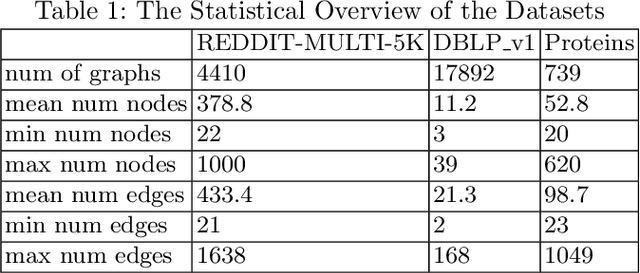
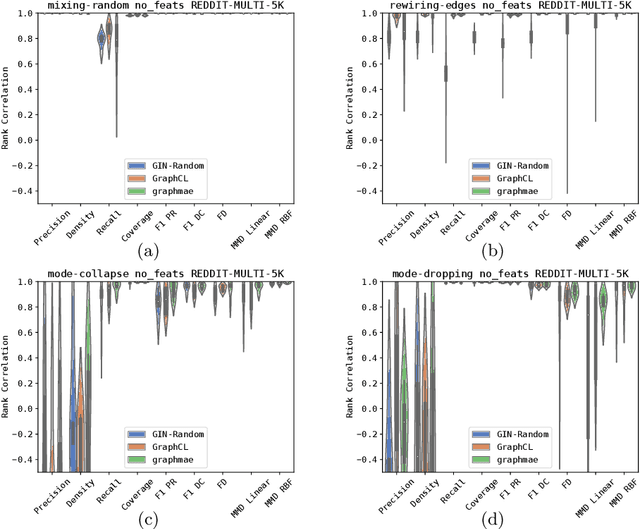
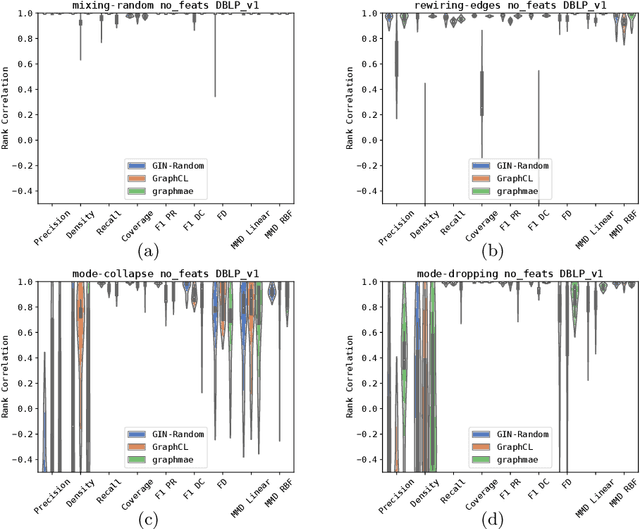
Abstract:In recent years, numerous graph generative models (GGMs) have been proposed. However, evaluating these models remains a considerable challenge, primarily due to the difficulty in extracting meaningful graph features that accurately represent real-world graphs. The traditional evaluation techniques, which rely on graph statistical properties like node degree distribution, clustering coefficients, or Laplacian spectrum, overlook node features and lack scalability. There are newly proposed deep learning-based methods employing graph random neural networks or contrastive learning to extract graph features, demonstrating superior performance compared to traditional statistical methods, but their experimental results also demonstrate that these methods do not always working well across different metrics. Although there are overlaps among these metrics, they are generally not interchangeable, each evaluating generative models from a different perspective. In this paper, we propose a novel method that leverages graph masked autoencoders to effectively extract graph features for GGM evaluations. We conduct extensive experiments on graphs and empirically demonstrate that our method can be more reliable and effective than previously proposed methods across a number of GGM evaluation metrics, such as "Fr\'echet Distance (FD)" and "MMD Linear". However, no single method stands out consistently across all metrics and datasets. Therefore, this study also aims to raise awareness of the significance and challenges associated with GGM evaluation techniques, especially in light of recent advances in generative models.
A Review of DeepSeek Models' Key Innovative Techniques
Mar 14, 2025Abstract:DeepSeek-V3 and DeepSeek-R1 are leading open-source Large Language Models (LLMs) for general-purpose tasks and reasoning, achieving performance comparable to state-of-the-art closed-source models from companies like OpenAI and Anthropic -- while requiring only a fraction of their training costs. Understanding the key innovative techniques behind DeepSeek's success is crucial for advancing LLM research. In this paper, we review the core techniques driving the remarkable effectiveness and efficiency of these models, including refinements to the transformer architecture, innovations such as Multi-Head Latent Attention and Mixture of Experts, Multi-Token Prediction, the co-design of algorithms, frameworks, and hardware, the Group Relative Policy Optimization algorithm, post-training with pure reinforcement learning and iterative training alternating between supervised fine-tuning and reinforcement learning. Additionally, we identify several open questions and highlight potential research opportunities in this rapidly advancing field.
A Consensus Privacy Metrics Framework for Synthetic Data
Mar 06, 2025Abstract:Synthetic data generation is one approach for sharing individual-level data. However, to meet legislative requirements, it is necessary to demonstrate that the individuals' privacy is adequately protected. There is no consolidated standard for measuring privacy in synthetic data. Through an expert panel and consensus process, we developed a framework for evaluating privacy in synthetic data. Our findings indicate that current similarity metrics fail to measure identity disclosure, and their use is discouraged. For differentially private synthetic data, a privacy budget other than close to zero was not considered interpretable. There was consensus on the importance of membership and attribute disclosure, both of which involve inferring personal information about an individual without necessarily revealing their identity. The resultant framework provides precise recommendations for metrics that address these types of disclosures effectively. Our findings further present specific opportunities for future research that can help with widespread adoption of synthetic data.
A Systematic Evaluation of Generative Models on Tabular Transportation Data
Feb 13, 2025Abstract:The sharing of large-scale transportation data is beneficial for transportation planning and policymaking. However, it also raises significant security and privacy concerns, as the data may include identifiable personal information, such as individuals' home locations. To address these concerns, synthetic data generation based on real transportation data offers a promising solution that allows privacy protection while potentially preserving data utility. Although there are various synthetic data generation techniques, they are often not tailored to the unique characteristics of transportation data, such as the inherent structure of transportation networks formed by all trips in the datasets. In this paper, we use New York City taxi data as a case study to conduct a systematic evaluation of the performance of widely used tabular data generative models. In addition to traditional metrics such as distribution similarity, coverage, and privacy preservation, we propose a novel graph-based metric tailored specifically for transportation data. This metric evaluates the similarity between real and synthetic transportation networks, providing potentially deeper insights into their structural and functional alignment. We also introduced an improved privacy metric to address the limitations of the commonly-used one. Our experimental results reveal that existing tabular data generative models often fail to perform as consistently as claimed in the literature, particularly when applied to transportation data use cases. Furthermore, our novel graph metric reveals a significant gap between synthetic and real data. This work underscores the potential need to develop generative models specifically tailored to take advantage of the unique characteristics of emerging domains, such as transportation.
Do You Know What You Are Talking About? Characterizing Query-Knowledge Relevance For Reliable Retrieval Augmented Generation
Oct 10, 2024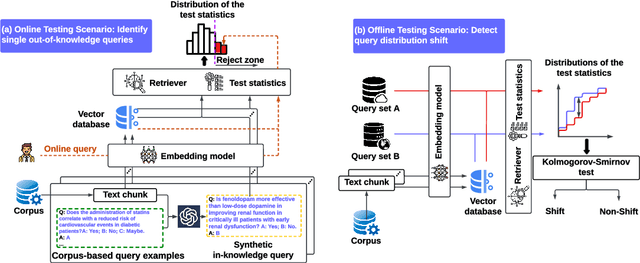



Abstract:Language models (LMs) are known to suffer from hallucinations and misinformation. Retrieval augmented generation (RAG) that retrieves verifiable information from an external knowledge corpus to complement the parametric knowledge in LMs provides a tangible solution to these problems. However, the generation quality of RAG is highly dependent on the relevance between a user's query and the retrieved documents. Inaccurate responses may be generated when the query is outside of the scope of knowledge represented in the external knowledge corpus or if the information in the corpus is out-of-date. In this work, we establish a statistical framework that assesses how well a query can be answered by an RAG system by capturing the relevance of knowledge. We introduce an online testing procedure that employs goodness-of-fit (GoF) tests to inspect the relevance of each user query to detect out-of-knowledge queries with low knowledge relevance. Additionally, we develop an offline testing framework that examines a collection of user queries, aiming to detect significant shifts in the query distribution which indicates the knowledge corpus is no longer sufficiently capable of supporting the interests of the users. We demonstrate the capabilities of these strategies through a systematic evaluation on eight question-answering (QA) datasets, the results of which indicate that the new testing framework is an efficient solution to enhance the reliability of existing RAG systems.
EMP: Effective Multidimensional Persistence for Graph Representation Learning
Jan 24, 2024Abstract:Topological data analysis (TDA) is gaining prominence across a wide spectrum of machine learning tasks that spans from manifold learning to graph classification. A pivotal technique within TDA is persistent homology (PH), which furnishes an exclusive topological imprint of data by tracing the evolution of latent structures as a scale parameter changes. Present PH tools are confined to analyzing data through a single filter parameter. However, many scenarios necessitate the consideration of multiple relevant parameters to attain finer insights into the data. We address this issue by introducing the Effective Multidimensional Persistence (EMP) framework. This framework empowers the exploration of data by simultaneously varying multiple scale parameters. The framework integrates descriptor functions into the analysis process, yielding a highly expressive data summary. It seamlessly integrates established single PH summaries into multidimensional counterparts like EMP Landscapes, Silhouettes, Images, and Surfaces. These summaries represent data's multidimensional aspects as matrices and arrays, aligning effectively with diverse ML models. We provide theoretical guarantees and stability proofs for EMP summaries. We demonstrate EMP's utility in graph classification tasks, showing its effectiveness. Results reveal that EMP enhances various single PH descriptors, outperforming cutting-edge methods on multiple benchmark datasets.
* arXiv admin note: text overlap with arXiv:2401.13157
Using AI Uncertainty Quantification to Improve Human Decision-Making
Sep 19, 2023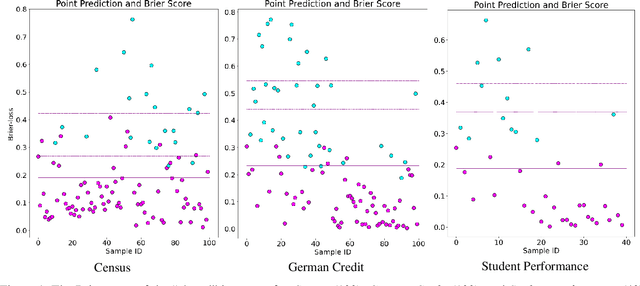


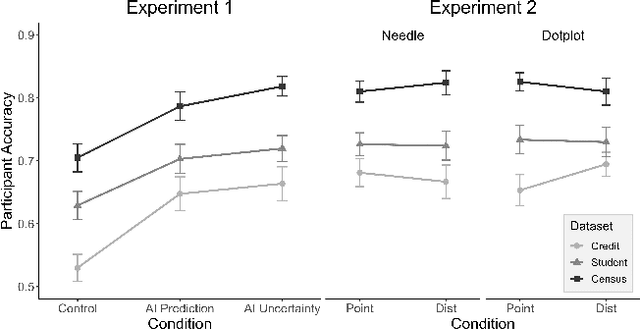
Abstract:AI Uncertainty Quantification (UQ) has the potential to improve human decision-making beyond AI predictions alone by providing additional useful probabilistic information to users. The majority of past research on AI and human decision-making has concentrated on model explainability and interpretability. We implemented instance-based UQ for three real datasets. To achieve this, we trained different AI models for classification for each dataset, and used random samples generated around the neighborhood of the given instance to create confidence intervals for UQ. The computed UQ was calibrated using a strictly proper scoring rule as a form of quality assurance for UQ. We then conducted two preregistered online behavioral experiments that compared objective human decision-making performance under different AI information conditions, including UQ. In Experiment 1, we compared decision-making for no AI (control), AI prediction alone, and AI prediction with a visualization of UQ. We found UQ significantly improved decision-making beyond the other two conditions. In Experiment 2, we focused on comparing different representations of UQ information: Point vs. distribution of uncertainty and visualization type (needle vs. dotplot). We did not find meaningful differences in decision-making performance among these different representations of UQ. Overall, our results indicate that human decision-making can be improved by providing UQ information along with AI predictions, and that this benefit generalizes across a variety of representations of UQ.
Interpreting GNN-based IDS Detections Using Provenance Graph Structural Features
Jun 06, 2023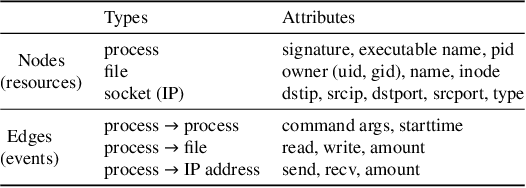
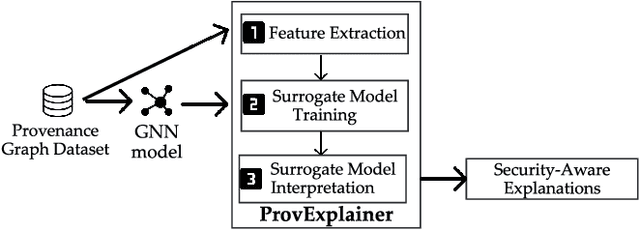
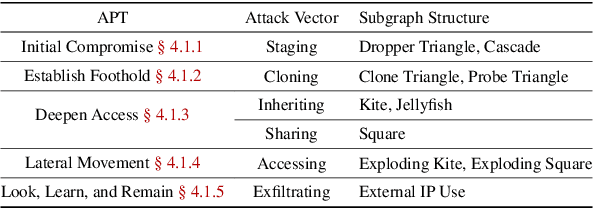
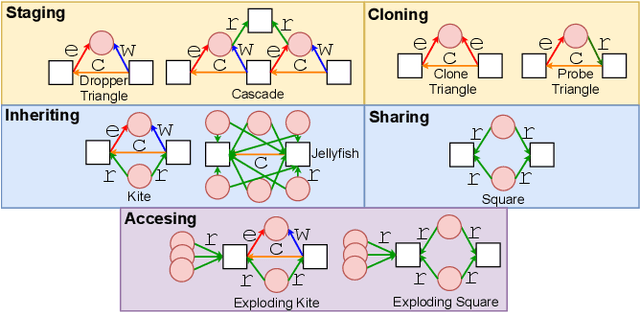
Abstract:The black-box nature of complex Neural Network (NN)-based models has hindered their widespread adoption in security domains due to the lack of logical explanations and actionable follow-ups for their predictions. To enhance the transparency and accountability of Graph Neural Network (GNN) security models used in system provenance analysis, we propose PROVEXPLAINER, a framework for projecting abstract GNN decision boundaries onto interpretable feature spaces. We first replicate the decision-making process of GNNbased security models using simpler and explainable models such as Decision Trees (DTs). To maximize the accuracy and fidelity of the surrogate models, we propose novel graph structural features founded on classical graph theory and enhanced by extensive data study with security domain knowledge. Our graph structural features are closely tied to problem-space actions in the system provenance domain, which allows the detection results to be explained in descriptive, human language. PROVEXPLAINER allowed simple DT models to achieve 95% fidelity to the GNN on program classification tasks with general graph structural features, and 99% fidelity on malware detection tasks with a task-specific feature package tailored for direct interpretation. The explanations for malware classification are demonstrated with case studies of five real-world malware samples across three malware families.
IoTFlowGenerator: Crafting Synthetic IoT Device Traffic Flows for Cyber Deception
May 01, 2023Abstract:Over the years, honeypots emerged as an important security tool to understand attacker intent and deceive attackers to spend time and resources. Recently, honeypots are being deployed for Internet of things (IoT) devices to lure attackers, and learn their behavior. However, most of the existing IoT honeypots, even the high interaction ones, are easily detected by an attacker who can observe honeypot traffic due to lack of real network traffic originating from the honeypot. This implies that, to build better honeypots and enhance cyber deception capabilities, IoT honeypots need to generate realistic network traffic flows. To achieve this goal, we propose a novel deep learning based approach for generating traffic flows that mimic real network traffic due to user and IoT device interactions. A key technical challenge that our approach overcomes is scarcity of device-specific IoT traffic data to effectively train a generator. We address this challenge by leveraging a core generative adversarial learning algorithm for sequences along with domain specific knowledge common to IoT devices. Through an extensive experimental evaluation with 18 IoT devices, we demonstrate that the proposed synthetic IoT traffic generation tool significantly outperforms state of the art sequence and packet generators in remaining indistinguishable from real traffic even to an adaptive attacker.
 Add to Chrome
Add to Chrome Add to Firefox
Add to Firefox Add to Edge
Add to Edge